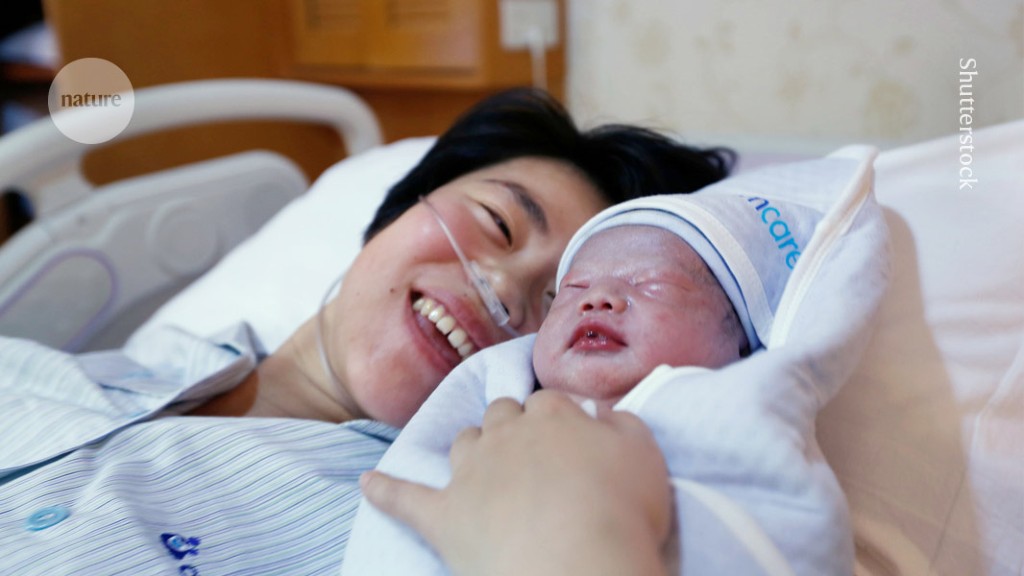New genetic variants found in large Chinese mother–baby study

The study is one of the first in Asia to examine links between the genomes of mothers, babies and their health

The Born In Guangzhou Cohort Study has surveyed 58,000 mother and baby pairs.Credit: Shutterstock
Mothers with higher blood pressure give birth to lighter and shorter babies than do mothers with lower blood pressure. This was just one of a multitude of links between maternal health and fetal development observed in a large genetic analysis of Chinese parents and their babies, which included some unexpected results.
The study, published in Nature today1, is among the first to look at the genetic profiles of East Asians, a largely under-represented population in genomic research, says Vicki Clifton, a researcher who studies maternal and child health at Mater Research in Brisbane, Australia. “The study fills an important gap in knowledge.”
The team looked at genetic data from participants in the Born in Guangzhou Cohort Study. Launched in 2012, the study has so far collected biological, environmental and social data on more than 58,000 babies born at the Guangzhou Women and Children’s Medical Centre and their families. Researchers have published a host of epidemiological studies on the cohort, but the latest is the first to analyse the trove of genetic data, says Xiu Qiu, an epidemiologist at the Guangzhou Women and Children’s Medical Center and the director of the cohort study. “We are opening a black box,” says Qiu.
Genetic effects
The analysis included 4,053 individuals in parent–child pairs or trios that included both parents. Participants were randomly selected from the larger Guangzhou group. Qiu and her colleagues sequenced genetic data from blood samples taken from the parents and umbilical-cord blood of the infants, and collected physical information about the mothers and their babies, including height and weight.
The researchers uncovered genetic variants that have not been observed in other populations. One variant was associated with weight gain in the mother during pregnancy. Another was associated with increased levels of bile acid and risk of developing the liver disease cholestasis in pregnant women, which has been linked to an increased risk of fetal death. The researchers say the variant could be more prevalent in East Asian mothers than in those from other regions because it also has a role in protecting people from the hepatitis B virus, which is common in China.
The researchers identified discrepancies in the effect of some genetic variants on the same trait between mothers and their babies. For example, some variants were associated with altered cholesterol levels in infants but not in their mothers, and vice versa. “That is really fascinating,” says Clifton, revealing the importance of a baby’s genes — not just the mother’s diet — in determining their cholesterol profile in the womb. These discrepancies between child and mother suggest that a person’s genetic risk profile could change with age or have an epigenetic component, which Qiu says they hope to further explore.
The researchers also developed a method to look at how certain maternal attributes affect child growth. Their analysis confirmed some previously established links, including that mothers who are taller and have higher blood sugar levels when fasting have heavier babies, and mothers with higher blood pressure have lighter and shorter babies. In quantitative terms, they found, for example, that for every 1-centimetre increase in maternal height, there was an increase of 15 grams, on average, in infant birth weight.
The study also identified some new links. For example, mothers with higher levels of bile acid had shorter babies. Clifton says the analysis falls short of establishing causality but offers leads for further research.
More work needed
Genetic studies that explore links between genomes and disease are becoming increasingly popular, says Teri Manolio, director of the Division of Genomic Medicine at the National Human Genome Research Institute in Bethesda, Maryland. Manolio says they allow researchers to analyse data in an “agnostic fashion” and “find stuff you didn’t expect”. But Manolio cautions that the number of study participants is relatively small, and any associations would need to be confirmed in larger sample sizes and in experimental studies.
Nonetheless, Clifton is excited that the Guangzhou project is starting to yield findings. “We can look forward to a lot more data from this cohort and a lot more interesting outcomes,” she says.
doi: https://doi.org/10.1038/d41586-024-00270-x
This story originally appeared on: Nature - Author:Smriti Mallapaty


















